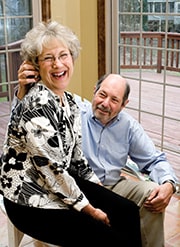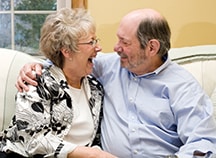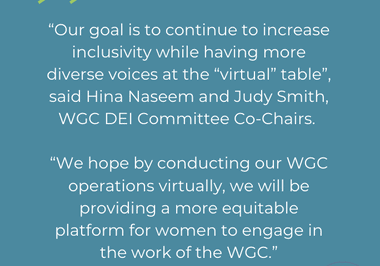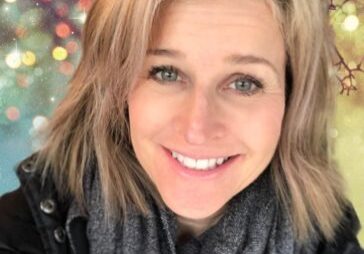COVERING THE GRAY IS A PROFESSIONAL AND PERSONAL REQUIREMENT
DOES SHE OR DOESN’T SHE?
STORY BY Marina Sarris PHOTOGRAPHY BY Meredith Tankersley
For many women, going gray can be a consequential decision.
The radio station announced a tornado watch, but I kept driving as the sky grew darker. My mission: to secure a bottle of my organic-yet-chemical-filled hair color to cover the gray. It wasn’t pure vanity. I had an upcoming job interview, and I worried that
Although no tornado materialized, I realized my folly in ignoring the weather. I wondered why many of us feel compelled to cover our gray, at some cost and inconvenience. Were my assumptions about gray hair even true?
My relationship with gray hair had begun innocently. I first noticed a streak of white in my 20s. It seemed like it might be an asset on the job: gray hair equals experience, right? So I left it alone.
Eventually I began to color it, at first casually, later in more earnest. One day a sales clerk eyed my white roots and mistook me for my children’s grandmother. After that, I became serious about covering the “skunk stripe” where my dark hair parted. By the time I made my tornado run, I was concealing the roots every two-and-a-half weeks, a time-consuming prospect. Many women of all ages enjoy controlling their own hair color, but I’m less enamored of the process.
Premature gray hair runs in my family, so I asked some of my male relatives, who had silver or white hair by age 50, why they didn’t feel a need to color it. One said his white hair made no difference to his career, and another said it was actually beneficial. “People stopped yelling at me when I went gray,” he joked.
Hair color is big business. A government fact sheet reports that more than a third of women – and 10 percent of men – color their hair. Other surveys report percentages that are even higher. Americans spent $3.7 billion on hair coloring at salons in 2007, a figure that represented 20 percent of all salon sales, according to U.S. Census data.
I may be in good company, but am I also responding to social pressure to look younger? Probably, I concluded, after speaking with Laura Hurd Clarke, Ph.D., an associate professor at University of British Columbia who studies aging.
In “Shades of Grey,” a research article published in the British-based “Ageing and Society” in 2010, she and a co-author track the history of hair dye and women’s attitudes toward aging. The beauty industry began marketing safer, better hair dyes in the 1930s and 1940s to women as a “means of self-expression.” By the 1950s women began covering gray to “mask their ages.”

In Clarke’s study, researchers surveyed three dozen women aged 71 and older about gray hair. Most of them disliked gray hair, which they associated with “poor health, social disengagement and cultural invisibility.” With gray hair, “you fade away into the background and no one sees you,” said an 89-year-old woman.
Clarke explains, “Women experience ageism based on looking older to a greater extent than men do. Men can be the youthful Adonis or the distinguished older man, but there isn’t an equivalent for women later in life. By and large, we don’t have a cultural assumption that aging is beneficial to women’s appearance.
“The closest we have is the notion of a cougar, which isn’t a distinguished term,” she says. Some argue that a cougar – a 40-plus woman who dates younger men – connotes a certain power, but the term is “time-limited” to middle age, she says.
Companies now market “anti-aging” creams and lotions to women of all ages, she says. Botox and other cosmetic procedures add another dimension to women’s pursuit of the fountain of youth.
Some women enjoy coloring their hair, says Clarke, but she isn’t one of them. “I’ve stopped doing it in the last year or two,” admits the 43-year-old. “If I’m going to be a scholar who studies ageism and I’m going to raise my daughter to believe she is valued by more than her appearance, I will have to walk the walk,” she says. “It’s been very liberating, and it’s been good for my pocketbook.”
The double standard for gray hair is apparent in Hollywood, where graying is mostly a male phenomenon. Actors George Clooney, Daniel Day-Lewis and Richard Gere, to name a few, wear their hair gray with impunity.
They have been joined by a few women. Actresses Helen Mirren and Jamie Lee Curtis are unapologetically gray. Country singer Emmylou Harris wears her silver-white locks long and flowing.
Still, coloring one’s hair is routine for women in the public eye. Younger stars – think Lady Gaga – change hair colors so frequently that dyed gray hair has found itself in the mix of pink, lavender, cyan and red hairstyles on the pages of celebrity magazines.
Of course, outside of Hollywood, many women do wear their hair naturally gray – and love it.
Susan Neal-Lyman, 58, of Elkridge, swore she wouldn’t put “those chemicals” on her hair when she went gray. But she did, in her late 30s, when her brown hair became flecked with gray.
When she became a grandmother, she decided to she had had enough. “Six years ago I had my first grandchild, and I used to say when I became a grandmother, I will stop dyeing my hair,” says Ms. Neal-Lyman, a medical technologist.
But growing out one’s dyed hair can be complicated, especially if you used permanent color. To manage the transition, her stylist began adding highlights while her hair returned, over the course of a year, to its natural salt-and-pepper color. “I’m happy with it,” she says. “I save a lot of money on hair color.”
Monica Cioffi, 59, of Ellicott City was not concerned when her sandy hair began turning gray. She highlighted it for a while, but hasn’t colored it for at least five years. After she became a widow, she felt a certain pressure to color her hair as she eventually rejoined the dating world. “I’ve been told by friends that I have to color my hair,” she says.
But she rebelled. For one thing, she says, she was too busy. “At this stage of life, you have children, grandchildren, traveling, work and things to do. Who wants to spend two hours getting your hair colored?”
Some friends who work in marketing, recruitment or business color their hair because they believe a youthful appearance is an asset on their jobs, she says. But in her profession – nursing – gray hair is not a hindrance, she says. In fact, quite the contrary: “Every single hospital wants an experienced nurse,” explains Ms. Cioffi, manager of cardiovascular services at a Baltimore hospital.
Ms. Cioffi says she is happy with her hair and her age, thank you very much.
“I’m going to be 60 this year. I’ve worked damn hard to get where I am, to know who I am, and to be comfortable in my own skin.” As for gray hair, “it complements the woman I am at this stage in my life. I don’t think it makes me look old. It makes me look like who I am,” she says.
“And I have a boyfriend who thinks I’m really cute,” she adds with a chuckle. *




